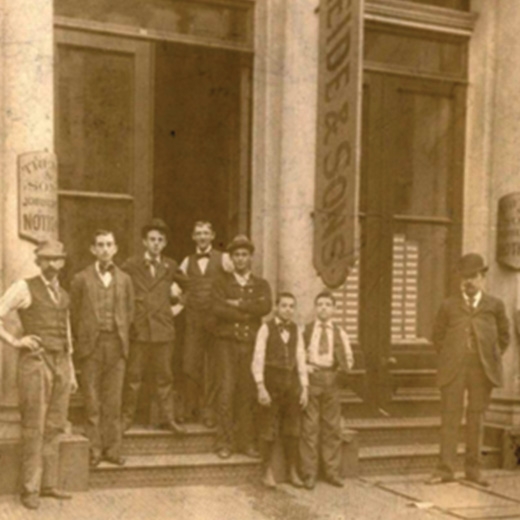
What Brands Can Learn From The General Store
One of the most commonly asked questions when engaging with brands is “How do I best connect with consumers in this new age?”. It’s a fair question as the process can be complex, overwhelming and intimidating. And with compounding environmental factors such as our changes in government, rapidly shifting consumer buying habits, an aggressive erosion of retail and a high level of cynicism from consumers (53% of consumers indicate that brands aren’t to be trusted and 78% of consumers indicate there is an authenticity gap between brands and consumers), steps to better consumer connectivity are easily convoluted as the gap widens between brand and consumer.
There’s an opportunity to connect directly with consumers across all demographic sectors.
Nearly every consumer group is becoming more confident shopping online and will continue to demonstrate greater digital courage. This trend is ideal for companies to connect across all demographics, whether focused on an increasingly tech savvy Hispanic market (a culture that responds to online ads better than the general user population), an ever-growing and actively-buying ecommerce Boomer (representing 70%+ of all disposable income), the over-hyped Millennial (80M just now entering the prime of their shopping years), or additional consumer segments peppered in-between. Building closer connections with relevant key influencers is critical to ensure a brand is positioned for long-term growth.
Brands must determine what makes them important and more meaningful.
As research indicates, building consumer connections is key. The answers lie in the foundational building blocks of brand creation and something our forefathers established as itinerant peddlers and owners of General Stores at the turn of the century. The values established by these early entrepreneurs are no different than what consumers are demanding from companies today.
My Great-Great Grandfather owned a prominent wholesale and retail dry goods business in the late 1800’s called JHC TREIDE DRY GOODS & NOTIONS. I’ve meticulously studied his archives and the information about the nature of the original direct-to-consumer business model and the purpose, values, and promises established for companies like his.



We’ve entered an era where brands are taking back the reins to direct relationships with their consumers.
Like similar family-owned mercantile businesses in that era, our forefathers crafted their companies to highlight their artisanal craft and benefit their customers. Their platforms brought the opportunity to curate a greater sense of community and deliver value to their customers. Prioritizing reliability around their products and services ensured repeat sales, earned consumer trust and accelerated positive word of mouth. And, through consistency over time these values earned their brands a badge of authenticity.
The very expectations (and fundamentals) that guided the General Stores of yesterday are what consumers hold brands and companies accountable to today. Quality, reliability, honesty and social good are four of the top demands.
QUALITY
Apparel phenom American Giant drew an aggressive line in the sand and promised to produce the best quality hoodie ever made. And then they actually did it. This thoughtful product is not only made in America but has a lifetime guarantee. It’s so popular that it often has a multi-month-waitlist. American Giant’s tagline, “don’t get comfortable” is a double entendre explaining their undying drive to deliver the best quality product possible alongside their audacious business ethos that always challenges the status quo.
RELIABILITY
There is a reason why Rolex, BMW, Disney and Google top Forbes’ list of the most reputable brands. Delivering reliability is deeply rooted in their commitment to the performance and consistency of their products, services and brand experiences across every consumer touchpoint. They’ve not only set high standards for themselves but have met equally lofty expectations of existing and potential consumers evidenced by surveys, user reports and industry studies.
HONESTY
Everlane operates from a position of “Radical Transparency” and encourages consumers to:
- Know your costs. Exposing that most products are marked up 8x, Everlane shares their costs. And in their “choose what you pay” offering, they show real prices and allow customers to either include, or not include, a cost markup.
- Know the factories. Everlane does their due diligence to find and secure factories that have stringent workplace compliancy and offer humane environments to their workers.
- Always ask why. Everlane’s credo of “Don’t Accept the Status Quo” shows their lack of complacency to move the business forward in ways that break the norm and deliver value through quality products.
SOCIAL GOOD
Patagonia received the Circular Disruptors award in January 2017 for their consistently sustainable innovations and for embedding the principles of the circular economy into its business strategy through its Worn Wear Initiative. They modestly accepted the award, stating “We have only begun to scratch the surface of what is possible with a circular economy model. There is still so much work to be done to change global consumption habits and encourage reuse and repair.”
As companies initiate, rebuild or refresh their direct-to-consumer relationships, it is imperative that they rally the wagons directly around their own critical values to convey their brand intent concisely and consistently. Connecting directly with consumers gives brands more control over the message they send and enables the opportunity to create a personal experience. Consumers today want to feel the ethos, lifestyle, and meaningful connection that warrants supporting a brand.
With a solid foundation, brands can focus on tapping into powerful, intimate and direct connectivity with consumers through tools that mine social intelligence. This is where the great brand-work-rubber hits the road. Strong values drive the curation and creation of live dashboards and other cutting edge intel with data that informs the right decision making across all facets of the business in alignment with influencer consumers. This granular level of detail helps brands further shift from an era of pay-to-spray into one of unparalleled and ongoing relationships. Relationships that have come full circle and would wow your (and my) forefathers.


Uncommon Person: Chad Hutson

Our Internal Learning & Impact at Bulldog Drummond

The One Decision by Employers in 2021 that Means Everything

What I Wish I Knew

Standing Up Inside

Uncommon Person: Gregg Imamoto

Five Things Every Company Should Know about ESG

Redefining Value

Uncommon Person: Chris Baréz-Brown

It’s Time For A Whole Lotta Common Good

Did You Choose Humanity?

Uncommon Partnership: Violux

Here’s How

Uncommon Person: Santhosh Nair

Designing Strategy For A Complex World

Responsibility & Relevance for Brands

